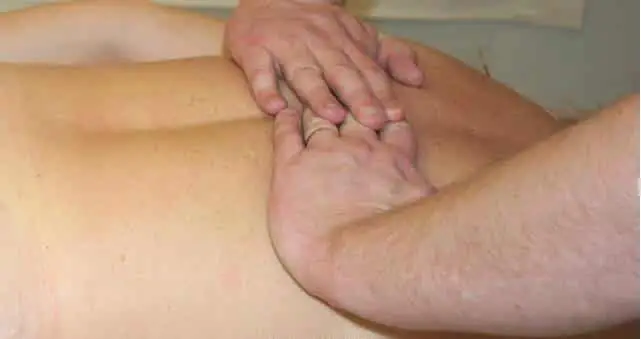Wondering or need to know, what is effleurage massage? – I can explain.
The word effleurage is a French word which means ‘stroke’ and is used to describe a smooth, gliding stroke used primarily in Swedish massage. But also applies to any other form of massage using this technique.
Effleurage techniques can be used all over the body. Like long gliding strokes across the back. As well as smaller muscle groups on massages such as on the face, head and hands.
The exact techniques, along with the speed and pressure will vary depending on the therapist, the client, and the problems that are being worked on. It allows for a versatile approach and can be tailored to suit a cclient’sneeds.
A therapy session will typically start off with some light effleurage techniques to test the areas being worked on and get the clienit used to the touch. Then other massage techniques will be used, such as tapotement and petrissage strokes and techniques.
Massage oil is generally applied to aid the techniques and improve the experience for the client. Deep effleurage techniques involve using some firm pressure and the need to slide easily around the clients skin.
The movements are generally guided toward the heart and from the extremities inwards. With the retuning strokes being softer and moving away from the centre of the body. This works with the body’s own blood flow and natural energy.
The therapy is incredibly relaxing and very effective at working out those tissue and muscle issues. The deep strokes will work out stubborn knots and leave the client feeling rejuvenated and relaxed.
Contents
What to Expect from an Effleurage Massage
Effleurage massage techniques are among the most basic and commonly used techniques. This isn’t a bad thing, and doesn’t mean it’s easy for anyone to do. More so it’s a reflection on how effective these techniques are and why they are used so commonly.
A key to this type of massage is that several different techniques get chained together without the therapist removing their hands off the clients body. Also, these strokes can be performed anywhere on the body. With adjustments being made for the area being targeted.
The strokes and movements used are relevantly slow and smooth compared to a lot of other techniques. With continuous strokes using the flat part of the hands. The therapist keeps their fingers together, and works them into the client’s body in a relaxing way.
The pressure is delivered from the palm of the hand. With an application of oil this comfortable for the client, and even with a great deal of pressure it should never be uncomfortable. When there is a need to work out knots and pain points there will be some discomfort of course, but the end result is a healing and relaxed feeling.
Effleurage strokes are repeated many times over the same areas on the body as the therapist works though muscle groups. This helps relax the muscles and has a range of other benefits, such as:
- Working out knots and muscle pains
- Stimulating the nerves in the skin and tissue
- Relaxes muscle fibers
- Stimulates the skin to renew cells
- Stimulating blood and oxygen flow to muscles
Maintaining continual contact through the therapy session is an important part of the process. A therapist will take their hands off the client only after several different techniques and types of strokes have been worked through.
A Look at the Four Basic Massgage Types of Movement
Effleurage makes up one of the four basic types of movement used in massage therapy. All four are:
- Effleurage
- Petrissage
- Friction
- Tapotement
Let’s take a closer look at these movements and how they differ from each other.
Effleurage
As already covered in detail in this article. Effleurage techniques consist of long, soothing stroking motions using the flat side of the hand. With the direction of the strokes going towards the heart to improve lymph flow and circulation.
Petrissage
Petrissage techniques involve various types of strokes and movements. Such as rolling, kneading, and picking at the skin and muscles. The intention here is to strengthen the structure of the fibers and tissues.
Supplying more blood and oxygen to the areas being worked on. Improving the flow of the lymph, and giving the client a complete all-round massage therapy.
Friction
Friction is a technique applied from using the knuckles, fingertips and thumb and applying deep pressure into a particular area or muscle. Also known as ‘connective tissue massage’, friction is commonly used to tackle specific issues.
Pressing motions and digging in with the knuckles loosen up the muscles for a more effective massage to work out any knots and tightness.
Tapotement
Tapotement is a term for several movements that involve a percussion rhythm. These include hacking, cupping, pummelling, and pounding. This type of massage is intended to be used on fleshy or large muscle groups at the impact can be painful on bony areas.
It’s particularly effective at toning and strengthening skin and muscles. Cellulite and the effects of aging can be worked on, along with some really relaxing and soothing effects.

I’m a MA, (CMT) Certified Massage Therapist, Licensed Massage Therapist (LMT), and Reiki Master — I’m a licensed massage therapist with over 10 years of experience in the industry.


